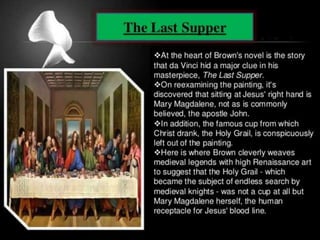The Da Vinci Code: Symbolism, History, And Controversy

Table of Contents
Deciphering the Symbolism in The Da Vinci Code
The novel is rich with symbolism, layered to create a multi-faceted narrative that keeps readers guessing. Understanding these symbols is key to grasping the core message and the overall intrigue of The Da Vinci Code.
The Holy Grail and its Multiple Interpretations
The Holy Grail, traditionally understood as the cup used by Jesus at the Last Supper, takes on a far more nuanced meaning in Brown's novel.
- Beyond the Chalice: Throughout history, the Grail has been interpreted as a physical object, a spiritual ideal, or even a metaphor for enlightenment.
- Mary Magdalene and the Sacred Feminine: Brown's portrayal centers on the Grail representing Mary Magdalene, suggesting a lineage of Jesus's bloodline and the suppression of the sacred feminine in religious history. This interpretation challenges traditional interpretations and sparked significant debate.
- Alchemical and Rosicrucian Symbols: The novel subtly weaves in alchemical and Rosicrucian symbols, further enriching the Grail's mystery. These esoteric traditions often associate the Grail with transformation and spiritual awakening, reflecting the narrative’s themes of hidden knowledge and rediscovery.
- Examples from the Book: The descriptions of the Grail's hidden location, the cryptic clues leading to it, and the symbolic representation within Da Vinci's paintings all contribute to this complex interpretation.
The Significance of the Priory of Sion
The Priory of Sion, a real-life organization, takes on a pivotal role in The Da Vinci Code. However, the book’s portrayal significantly departs from the Priory's actual historical significance.
- Fact vs. Fiction: The real Priory of Sion was a relatively obscure organization with a much less dramatic history than the one depicted in the novel. Brown’s fictionalization heavily emphasizes its secret mission and its alleged connection to powerful figures throughout history.
- Protecting the Secret: In the novel, the Priory is tasked with protecting the secret of Jesus's marriage to Mary Magdalene and their descendants. This secret, the book argues, has been systematically suppressed by the Catholic Church for centuries.
- Symbolic Importance: The Priory’s purported lineage, tying it to historical figures like Da Vinci and others, enhances the narrative's suspense. The organization becomes a symbol of the ongoing struggle between hidden knowledge and established power structures.
- Building Suspense: Brown masterfully uses the Priory’s clandestine activities and its alleged historical influence to create a compelling atmosphere of secrecy and intrigue.
The Role of Da Vinci's Art and its Hidden Meanings
Leonardo da Vinci's art serves as a crucial element in The Da Vinci Code, acting as a visual puzzle box filled with hidden clues and symbolic representations.
- Symbolic Interpretations: Brown analyzes works like The Last Supper and Mona Lisa, assigning them symbolic meanings that often challenge conventional interpretations.
- Perspective and Composition: The novel highlights how Da Vinci's use of perspective, composition, and symbolism within his paintings provides visual clues to support the narrative's hidden message.
- Creating Visual Clues: The subtle details, hidden figures, and geometric patterns within the paintings serve as visual clues directing the protagonist towards the truth.
- Artistic Techniques: The exploration of sfumato techniques and other artistic intricacies attributed to Da Vinci’s work, adds layers of hidden meaning to the analysis, creating a visual narrative within the narrative.
Historical Context and Accuracy in The Da Vinci Code
While a work of fiction, The Da Vinci Code draws upon actual historical events, figures, and religious texts, sparking debates about historical accuracy and interpretation.
The Historical Jesus and the Gnostic Gospels
The book contrasts traditional accounts of Jesus's life with those found in the Gnostic Gospels.
- Contrasting Accounts: The Gnostic Gospels present alternative perspectives on Jesus’s life, teachings, and divinity. They differ significantly from the canonical Gospels in their theological interpretations.
- Impact on Religious Interpretations: The differences between canonical and Gnostic texts have fueled centuries of theological debate and impacted interpretations of early Christianity.
- Incorporating Alternative Narratives: Brown incorporates these alternative narratives to support his fictional storyline, presenting a view of Jesus’s life and teachings that diverge from traditional interpretations.
- Controversy Surrounding Gnostic Accounts: The historical accuracy and authenticity of the Gnostic Gospels remain subjects of ongoing scholarly debate, further fueling the controversy surrounding The Da Vinci Code.
Mary Magdalene's Role in Early Christianity
The novel reimagines Mary Magdalene's role, challenging traditional interpretations of her relationship with Jesus.
- Historical Evidence and Interpretations: Historical evidence surrounding Mary Magdalene is scarce and open to interpretation, leading to conflicting views about her importance in early Christianity.
- Differing Perspectives: Some scholars view her as a devoted follower, while others suggest a more intimate relationship with Jesus, influencing Brown’s interpretation.
- Brown's Portrayal: Brown elevates her from a repentant sinner to a significant figure, central to the narrative and the secret of Jesus’s lineage.
- Feminist Interpretations: Brown's portrayal resonated with feminist interpretations of religious history, highlighting the potential suppression of women's roles in early Christianity.
The Templar Order and its Legacy
The Knights Templar, a powerful medieval military order, adds another layer of historical intrigue to the novel.
- The Crusades and Suppression: The Templars played a significant role in the Crusades before their dramatic downfall and suppression in the 14th century.
- Connection to the Priory of Sion: Brown links the Templars to the Priory of Sion, suggesting a continuation of their secretive mission to protect the bloodline of Jesus.
- Enduring Myths and Legends: The Templars' legacy is surrounded by myths and legends, including those about hidden treasures and secret knowledge, furthering the narrative's mystery.
- Enhancing Mystery and Adventure: Brown cleverly utilizes the Templars' historical background to intensify the novel's mystery and adventure, adding to the thrill of the story.
The Controversies Surrounding The Da Vinci Code
The book's publication generated significant controversy, sparking debates across religious, academic, and legal spheres.
Religious and Historical Criticism
The Da Vinci Code faced intense criticism from various religious groups and scholars.
- Accusations of Inaccuracies: Critics challenged the book's historical accuracy, pointing out misinterpretations of religious texts and historical events.
- Portrayal of the Catholic Church: The novel's portrayal of the Catholic Church sparked significant controversy, with accusations of bias and misrepresentation.
- Responses from Religious Groups: Various religious groups and institutions expressed strong disapproval, highlighting the potential for the book to misinform and offend.
- Scholarly Debates: Academics debated the historical validity of the book’s claims and interpretations, further fueling public discussion.
Legal Challenges and Censorship
The novel's controversial nature led to legal battles and censorship attempts in several countries.
- Attempts to Suppress the Book: Some groups sought to ban or suppress the book, arguing it was blasphemous or historically inaccurate.
- Arguments for Suppression: Opponents argued that the book could incite religious hatred or cause harm to public morality.
- Freedom of Speech Implications: The controversies surrounding The Da Vinci Code raised important issues regarding freedom of speech and the limits of censorship.
- Legal Outcomes: Legal challenges largely failed, upholding the right to publish and distribute the book, despite ongoing debate over its content.
The Book's Impact on Popular Culture and Public Perception
The Da Vinci Code's enduring popularity has significantly impacted popular culture and public perception.
- Influence on Media: The novel’s success inspired a film adaptation, video games, and other media, further disseminating its themes and interpretations.
- Increased Interest in History: The book sparked renewed interest in religious history, symbolism, and the historical Jesus, leading to increased discussion and investigation of related topics.
- Influencing Public Perception: The book’s presentation of alternative narratives influenced public perception of history, religion, and the role of women in early Christianity.
- Enduring Fascination: The enduring fascination with the mysteries and secrets surrounding the book continues to contribute to its lasting legacy and ongoing debate.
Conclusion
The Da Vinci Code remains a captivating work of fiction that cleverly interweaves historical events, religious interpretations, and compelling symbolism to create a thrilling narrative. While its historical accuracy has been debated extensively, its impact on public awareness and the ongoing discussions about religious history and the role of women in Christianity are undeniable.
Dive deeper into the mysteries surrounding The Da Vinci Code! Explore the symbolism, research the historical figures, and form your own opinions on this controversial yet captivating novel. Continue the investigation and unravel the enduring mysteries of The Da Vinci Code for yourself.

Featured Posts
-
 Ayorbaba Himbau Dukungan Penuh Untuk Persipura Jayapura
May 13, 2025
Ayorbaba Himbau Dukungan Penuh Untuk Persipura Jayapura
May 13, 2025 -
 Significant Rise In Manufacturing Cybersecurity Investment 63 5 Survey Result
May 13, 2025
Significant Rise In Manufacturing Cybersecurity Investment 63 5 Survey Result
May 13, 2025 -
 No Upsets For Sabalenka And Gauff In Rome
May 13, 2025
No Upsets For Sabalenka And Gauff In Rome
May 13, 2025 -
 Springwatch In Japan Experiencing Cherry Blossom Season
May 13, 2025
Springwatch In Japan Experiencing Cherry Blossom Season
May 13, 2025 -
 Cassie And Alex Fine At Courthouse Amid Diddy Sex Trafficking Case
May 13, 2025
Cassie And Alex Fine At Courthouse Amid Diddy Sex Trafficking Case
May 13, 2025
